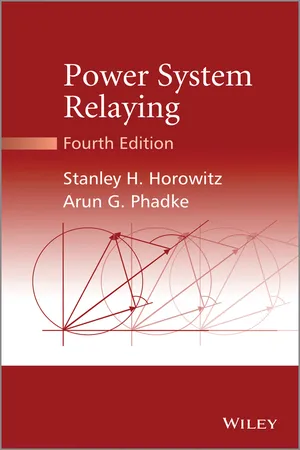
- English
- ePUB (mobile friendly)
- Available on iOS & Android
Power System Relaying
About this book
With emphasis on power system protection from the network operator perspective, this classic textbook explains the fundamentals of relaying and power system phenomena including stability, protection and reliability. The fourth edition brings coverage up-to-date with important advancements in protective relaying due to significant changes in the conventional electric power system that will integrate renewable forms of energy and, in some countries, adoption of the Smart Grid initiative.
New features of the Fourth Edition include:
- an entirely new chapter on protection considerations for renewable energy sources, looking at grid interconnection techniques, codes, protection considerations and practices.
- new concepts in power system protection such as Wide Area Measurement Systems (WAMS) and system integrity protection (SIPS) -how to use WAMS for protection, and SIPS and control with WAMS.
- phasor measurement units (PMU), transmission line current differential, high voltage dead tank circuit breakers, and relays for multi-terminal lines.
- revisions to the Bus Protection Guide IEEE C37.234 (2009) and to the sections on additional protective requirements and restoration.
Used by universities and industry courses throughout the world, Power System Relaying is an essential text for graduate students in electric power engineering and a reference for practising relay and protection engineers who want to be kept up to date with the latest advances in the industry.
Frequently asked questions
- Essential is ideal for learners and professionals who enjoy exploring a wide range of subjects. Access the Essential Library with 800,000+ trusted titles and best-sellers across business, personal growth, and the humanities. Includes unlimited reading time and Standard Read Aloud voice.
- Complete: Perfect for advanced learners and researchers needing full, unrestricted access. Unlock 1.4M+ books across hundreds of subjects, including academic and specialized titles. The Complete Plan also includes advanced features like Premium Read Aloud and Research Assistant.
Please note we cannot support devices running on iOS 13 and Android 7 or earlier. Learn more about using the app.
Information
Chapter 1
Introduction to Protective Relaying
1.1 What is Relaying?
1.2 Power System Structural Considerations
1.2.1 Multilayered Structure of Power Systems

1.2.2 Neutral Grounding of Power Systems
Table of contents
- Cover
- Title Page
- Copyright
- Preface to the Fourth Edition
- Preface to the Third Edition
- Preface to the Second Edition
- Preface to the First Edition
- Chapter 1: Introduction to Protective Relaying
- Chapter 2: Relay Operating Principles
- Chapter 3: Current and Voltage Transformers
- Chapter 4: Nonpilot Overcurrent Protection of Transmission Lines
- Chapter 5: Nonpilot Distance Protection of Transmission Lines
- Chapter 6: Pilot Protection of Transmission Lines
- Chapter 7: Rotating Machinery Protection
- Chapter 8: Transformer Protection
- Chapter 9: Bus, Reactor, and Capacitor Protection
- Chapter 10: Power System Phenomena and Relaying Considerations
- Chapter 11: Relaying for System Performance
- Chapter 12: Switching Schemes and Procedures
- Chapter 13: Monitoring Performance of Power Systems
- Chapter 14: Improved Protection with Wide Area Measurements (WAMS)
- Chapter 15: Protection Considerations for Renewable Resources
- Appendix A: IEEE Device Numbers and Functions
- Appendix B: Symmetrical Components
- Appendix C: Power Equipment Parameters
- Appendix D: Inverse Time Overcurrent Relay Characteristics
- Index